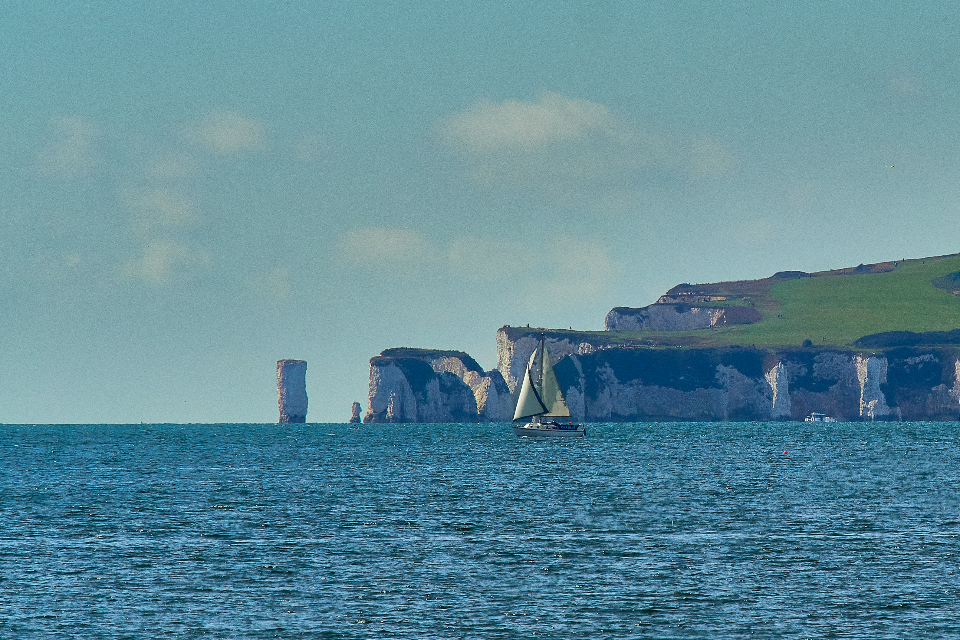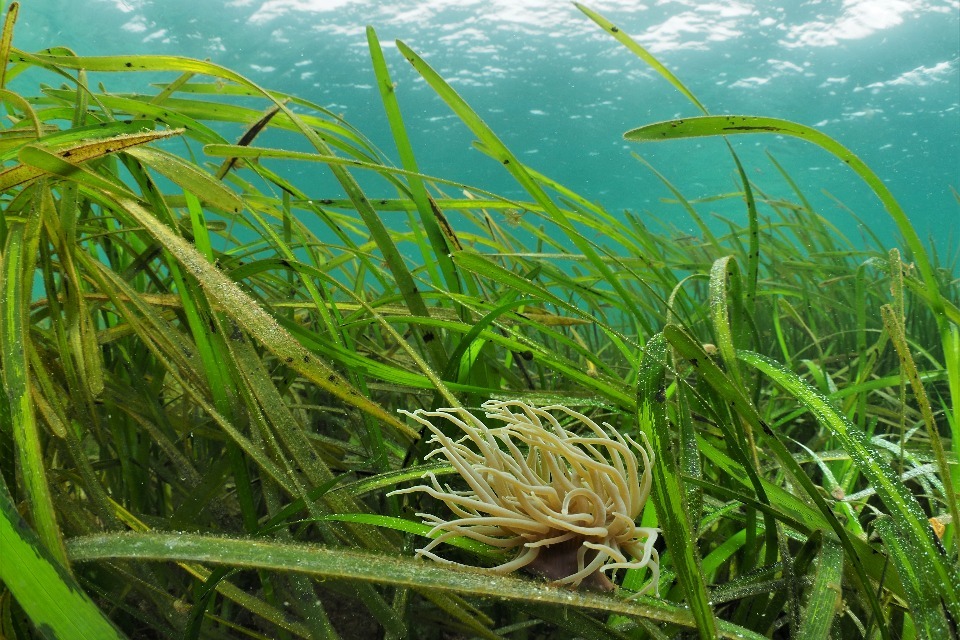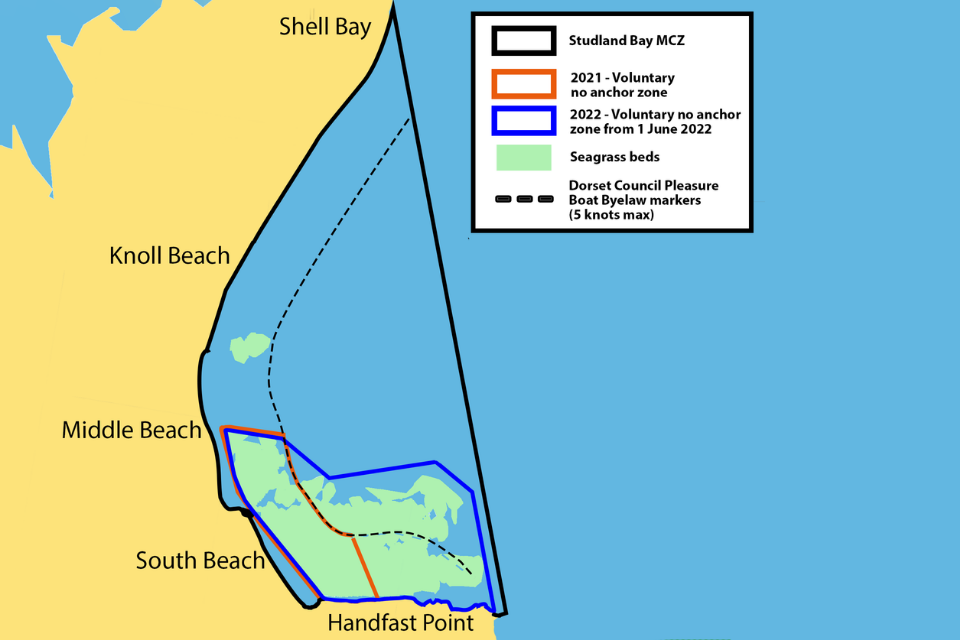Managing marine non-licensable activity in Studland Bay Marine Conservation Zone
This page details the MMO’s work on the management of marine non-licensable activity in Studland Bay Marine Conservation Zone (MCZ).
Documents
Details

Studland Bay: Dorset’s priceless hidden ecosystem
Studland Bay, located on the South coast of Dorset, is renowned for its sandy beaches, sheltered waters, anchorage and stunning views. Hidden below the surface lies a vital seagrass habitat offering numerous benefits to the local community, environment and economy. The beauty of Studland Bay attracts tourists from around the world, providing a boost to the nearby businesses and the local economy. This area also has become a popular destination for school trips, helping to teach children about the geography and wildlife of this invaluable habitat.
People enjoy swimming and snorkelling in the clean water of Studland Bay in part thanks to its underwater seagrass meadows which have an incredible ability to improve water quality by filtering surrounding waters. Additionally, seagrass meadows act as a natural barrier, protecting the coastline from erosion and reducing the impact of incoming waves and storms, safeguarding nearby communities, infrastructure and valuable habitats. Seagrass also contributes to global efforts to combat climate change by capturing and storing significant amounts of carbon, acting as an effective carbon sink.
Seagrass in Studland Bay provides essential habitats for a wide range of marine wildlife, serving as nurseries and feeding grounds for various species, including rare species of seahorse, pipefish and rays. Studland Bay is particularly important to long-snouted seahorse, as it is the only known area in the UK in which they breed. Crustaceans, molluscs and worm species also benefit from the shelter provided by the seagrass, as well as fish species of significant commercial value such as seabream, bass and flat fish.

Seagrass, an important underwater habitat. Credit: Michiel Vos / Ocean Image Bank
The importance of protecting Studland Bay’s ecosystem
By protecting and recognising the seagrass meadows, we ensure a healthier, more resilient coast, a thriving marine environment and a sustainable local economy for generations to come.
The Studland Bay ecosystem is threated by several factors such as climate change, ocean acidification, water quality and the physical impacts of anchors from high levels of recreational boating. Dropping anchors into the seagrass beds can damage and uproot the seagrass (scouring), impacting the many species sheltered by the seagrass. This damage also affects the health and functioning of this habitat, impacting its ability to provide critical services benefitting society, including carbon storage and flood protection.
Seagrass thrives particularly well in certain conditions, including relatively sheltered areas. The sheltered conditions which make the southern part of Studland Bay an area particularly suitable for seagrass but also an attractive anchorage. This is an unfortunate coincidence, as we also know that anchoring on the seagrass beds results in damage to the beds, reducing its ecological condition.
How to prevent anchor damage
Seagrass is easily damaged by the dropping and weighing of boat anchors, which can drag along the seabed, expose the roots, leave large anchor scars, fragment the habitat and permanently damage the seagrass beds beyond recovery.
The urgent need to protect and safeguard this type of habitat for the future is becoming increasingly important due its vital role in absorbing carbon from surrounding seawater and stabilising the seabed, which can help to reduce coastal erosion and mitigate the impact of climate change.
- We ask you to please anchor outside the voluntary no anchor zone, located off South Beach out to Harry Rocks, where possible.
- Ecomoorings, which do not damage the seagrass beds, are also available in the nearby area.
- We also ask you to take extra care when moving in the nearshore area of South Beach. This is a known habitat for the legally protected long-snouted seahorses, (also known as spiny seahorses).
MMO expects seagrass extent to vary across seasons, as such we ask you to be mindful of this and anchor away from seagrass.
Safety at Sea
We recognise that this area is important safety refuge for vessels. Safety of life at sea will always come first. The right to anchor under emergency conditions, or to avoid a genuine emergency situation, within Studland Bay will continue.
Studland Bay MCZ and voluntary no anchor zone
The Studland Bay Marine Conservation Zone (MCZ) was formally designated on the 31 May 2019 and covers 6 nautical miles along the Dorset coast. The MCZ protects 4 designated features: the seagrass beds, intertidal coarse sediment, long-snouted seahorse (also known as spiny seahorses) and subtidal sand.
It’s MMO’s responsibility to protect these designated features by managing non-licensable marine activities. Based on the best available evidence and advice from Natural England, MMO determined that anchoring is not compatible with consideration of the objectives of Studland MCZ, due to the physical damage it can cause to seagrass beds. Management is therefore necessary to support the recovery of the seagrass beds to favourable condition.
After consultation with the boating community, partners and other users of the bay, the voluntary no anchor zone (VNAZ) was introduced in 2021. The seagrass beds located off South Beach and Middle Beach receive the majority of anchoring within the site, therefore MMO has decided to introduce a voluntary no anchor zone into this main seagrass bed within Studland Bay MCZ to limit the damage from anchoring and help in the recovery of the seagrass habitats and species.
MMO understands that the voluntary no anchor zone (VNAZ) has an inevitable impact on the boating community. We must nevertheless balance this against MMO duties to protect and enhance our marine environment for current and future generations.

Studland Bay Map
The shapefiles for the zones can be downloaded via the links below. Please also see the Studland Bay MCZ Habitat Protection Strategy for additional maps displaying these zones, coordinates and further information.
- Shapefile from Defra group ArcGIS Online organisation
- Feature Layer from Defra group ArcGIS Online organisation
MMO has also worked to incorporate Studland Bay VNAZ coordinates into several electronic charts, which we know are widely available for boating community.
Studland Bay Marine Partnership
The Studland Bay Marine Partnership (SBMP) is an organisation made up of local stakeholders including conservation and boating groups, academics, grassroots community groups and local businesses.
The group has worked tirelessly to find solutions that meet the needs of local people and recreational boaters, enabling them to continue to enjoy the bay, whilst protecting and restoring the sensitive seagrass habitat at Studland. This includes fundraising initiatives to aid with the installation of advanced ecomoorings within the bay, providing a sustainable alternative to anchoring in the VNAZ for those coming to the area.
MMO is committed to working closely with partners, including the Studland Bay Marine Partnership to ensure the protection of the seagrass beds and other protected habitats and species in Studland Bay.
Environmentally friendly moorings
MMO has supported the work of Studland Bay Marine Partnership with the delivery of their ecomooring project through the marine licencing process and funding provided through the Fisheries and Seafood Scheme (FaSS). Studland Bay Marine Partnership - FaSS Case study - GOV.UK
A total of 87 ecomoorings are now available to use in the bay during the main boating season for a small mooring fee.
The ecomoorings provide an easy to use and environmentally friendly alternative to regular anchors, which can damage the seabed.
Guidance on obtaining license for private moorings
We’ve produced guidance on the environmental benefits of advanced mooring systems over traditional moorings, as well as the consent and marine licencing process.
Moorings, consents and advice - GOV.UK
MMO understands that advanced mooring systems are an important alternative to anchoring, in order to support sustainable use of the area and effectiveness of the voluntary no anchor zone.
The installation of moorings is managed through the MMO marine licensing process. The installation, maintenance and removal of both temporary seasonal moorings and permanent moorings would require an application to MMO for determination. Please see our website for further information on the marine licensing process, timescales and associated fees.
Make a marine licence application - GOV.UK (www.gov.uk)
The Studland Bay MCZ Habitat Protection Strategy provides guidance to those interested in applying for moorings in Studland Bay and advises the use of advanced mooring systems to protect the seagrass beds in the site.
If you require any support with the application system, please contact our support team on marine.consents@marinemanagement.org.uk
Management Approach
The Studland Bay MCZ Habitat Protection Strategy provides an overview of MMO’s management approach for marine non-licensable activities in Studland Bay MCZ. In addition, guidance is provided regarding installation of moorings. A summary is provided below.
MMO introduced a phased voluntary approach for the management of anchoring in Studland Bay MCZ over 2021 and 2022.
-
Phase 1 commenced on 17 December 2021. An interim voluntary no anchor zone (VNAZ) was introduced.
-
Phase 2 commenced on 1 June 2022. In phase 2, the interim zone was replaced by a larger VNAZ to protect the majority of the of seagrass habitat in the Bay.
-
Phase 3 We continue to highlight the voluntary measures, engage the community and encourage boat users to not anchor in the zoned area to protect the designated habitats and species which are sensitive to anchoring damage.
Other marine non-licensable activities
A monitoring and control plan has been put in place for all the other marine non-licensable activities which were taken forward for assessment. No further management is being introduced for other activities at this time.
Voluntary no anchor zone review
MMO has now completed its 2024 Review of the effective of the Studland Bay VNAZ.
We conduct annual reviews to enhance our understanding of how the VNAZ is protecting the site, what’s worked well, and what can be improved so we can ensure the area continues to be best protected for the future.
This is the third review published since the VNAZ was established in 2021. The review indicates that:
-
Anchoring over protected areas of seagrass is continuing to decrease
-
There has been an increase in boaters using ecomoorings when available.
-
Boaters are anchoring outside the VNAZ when no moorings are available.
-
Marker buoys introduced last season are helping boaters to better identify the protected habitats and avoid anchoring in those areas.
-
Seagrass is recovering to a more favourable condition.
This leads MMO to conclude that the VNAZ remains the most effective method to protect the MPA as positive progress continues. We remain committed to working together with the community to deliver activities and raise awareness for the importance of seagrass habitat protection in Studland Bay throughout 2025.
Stakeholder Engagement
October 2020 - MMO call for evidence
MMO sought stakeholder views on the draft assessment of the impacts of marine non-licensable activities in Studland Bay MCZ and proposed management options. Following a review of all feedback received from the call for evidence, it was concluded that management measures would be developed for anchoring due to the pressure it causes at current levels towards the designated features of the MCZ. The Studland Bay MCZ Decision Document detail MMO’s response to feedback received.
March 2021 – formal engagement period
Dorset Coast Forum facilitated a formal engagement period for MMO to gain further input from stakeholders about three draft anchoring management options. The purpose of this was to inform the approach to managing anchoring in Studland Bay MCZ and to ensure the necessary level of environmental protection while minimising impacts on users of the sea. A summary of the engagement can be found on the Dorset Coast Have Your Say website.
September 2021 – Studland Bay MCZ Habitat protection Strategy launch
MMO announced the voluntary approach to stakeholders. MMO engaged with representatives from key stakeholder groups to share information and invite feedback.
Engagement activities
Please follow us on social media for the latest updates. Twitter, Facebook, LinkedIn and Instagram.
Contact us
Please contact us if you have any queries, feedback and/or suggestions: conservation@marinemanagement.org.uk
Updates to this page
-
The Studland Bay Voluntary No Anchor Zone 2022 Review has now been published.
-
Small update
-
New coordinates sheet
-
Studland Update
-
Studland Leaflet
-
Content changes in line with date change
-
Page updated following the introduction of a phased voluntary approach for the management of anchoring in Studland Bay Marine Conservation Zone (MCZ).
-
Updated page with Stakeholder Meeting 10 September 2021
-
name change for documents
-
Updated content in line with progress in the call for evidence.
-
Amends
-
First published.